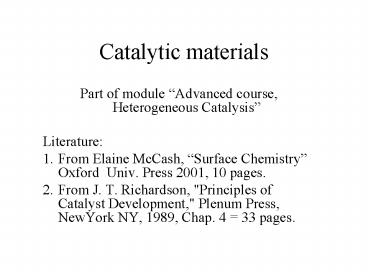Catalytic materials - PowerPoint PPT Presentation
1 / 30
Title:
Catalytic materials
Description:
From Elaine McCash, 'Surface Chemistry' Oxford Univ. Press 2001, 10 pages. ... Other reactions occur with equal rates on all atoms (insensitive or facile reactions) ... – PowerPoint PPT presentation
Number of Views:89
Avg rating:3.0/5.0
Title: Catalytic materials
1
Catalytic materials
- Part of module Advanced course, Heterogeneous
Catalysis - Literature
- From Elaine McCash, Surface Chemistry Oxford
Univ. Press 2001, 10 pages. - From J. T. Richardson, "Principles of Catalyst
Development," Plenum Press, NewYork NY, 1989,
Chap. 4 33 pages.
2
Heterogeneous catalysts examples
- Metals
- Dispersed on a support
- Porous (e.g.Raney nikkel)
- Bulk metals
- Oxides
- Single metal oxides
- Mixed oxides
- Zeolites
- Sulfides
- Acids
- Bases
- Carbides
- Nitrides
- Molten salts
- Anchored catalysts
- homogeneous complexes
- enzymes
3
Ideal structures
4
Surfaces are described using Miller-indices
- Find the unit cell and place the surface in an
x-y-z- coordinate system - Identify the intercepts with the x, y og z axes
- Identify the reciproke of the intercept
- If the intercept is a fraction multiply up to get
integer indeces (usually called (hkl))
Animation from http//www.doitpoms.ac.uk/tlplib/m
iller_indices/lattice_index.php
5
Typical low-index surfaces (most common)
- Examples of surfaces on a somple cubic crystal
- 100 010 001 (not shown)
6
Sphere models
- Illustrates that
- 111 is most dense
- 100 is more open
- 110 is most open, with furrows between the rows
in the top layer - Key point The surface is different from the bulk
- Neighbouring atoms in a single direction only
gives rise to the surface energy
7
A metal particle (ideal) exposes different
crystal faces
8
Unit-cellSmallest repeating unit that describes
the entire surface
9
Distances and atom densities (atoms/surf.area)
can be determined and is tabulated for different
metals
10
Real surfaces also expose steps, kinks and
missing atoms
- Surface defects are often important for catalysis
- Atoms in defect sites are even less coordinated
(have fewer nearest neighbours) than atoms in
dense faces - Open to bond reactants
11
Bonding (chemisorption) involves interacting
orbitals
12
(No Transcript)
13
Metals Surface structure and atom distance can
explain bonding Example ethylene on nickel
- Ni-Ni 0.25 nm gives Ni-C-C 105
- Ni-Ni 0.35 nm
- gives Ni-C-C 123
- 100 and 110 is active, form reactive adsorbates
- 111 is less active
14
Activity for ethylene hydrogenation
15
Example Ammonia synthesis on Fe
- Depending on the crystal plane the activity is
very different - The 111-face is much more active than 100 and 110
- The real Fe catalyst can be modelled based on the
activity of a Fe-111 single crystal and the
fraction of the surface that exposes the 111 plane
16
Real particles exposes many different faces and
edge/corner sites
- Real particles are non-ideal
- Cubo-octahedric particle is often used as a model
for real particles - Exposes 100, 110, 111 and a range of edges and
corners
17
Crystallite size is important
- With increasing particle radius
- Fraction low-index planes increases
- Fraction corner and adge sites decreases
- For some reactions this influences the activity
(structure sensitive reactions) - Other reactions occur with equal rates on all
atoms (insensitive or facile reactions)
18
Structure sensitve reaction cyclohexane
dehydrogenation/hydrogenolysis
- With increasing metal particle size
- Increasing dehydrogenation
- Favoured by low-index planes (dense planes)
- Hydrogenolysis decreases
- Favoured by corner/edge sites
- Can be used in catalyst design
19
Large particlesTransition between dense planes
give rise to more active sites
20
Oxides Semiconductors
- (n) og (p)-type semiconductors can be active
catalysts - Typical mechanisms involve red-ox processes -
electron exchange
21
Example Ethanol decomposition
- The Fermi-level increases from top to bottom in
the table, leading to - Dehydrogenation increases
- Dehydration decreases
- Same type of trend seen in other oxide-catalysed
reactions, e.g photo-catalysis
22
Insulators Solid acids and bases
23
Acidity varies with materials
Silica-alumina is a strong acid
24
Oxsides Zeolites
- Crystalline materials built by oxygen tetrahedra
connected by metal atoms (Si and Al) - Tetrahedra linked by common O-atoms to form
octahedra (sodalite cages) - Sodalite-cages are building blocks for a range of
structures
25
Example A-zeolite
- 4-ring openings
- Cavities with 0.7 nm openings
- Adsorbs water and other small molecules, used in
separation, drying etc.
26
Faujasite og mordeniteExamples of 12-ring
structures
27
Simulation shows molecular sieve effect
28
(No Transcript)
29
ZSM-53-dimensional network of pores
30
3 different mechanisms for selectivity in zeolites
- Reactants selected due to size, large molecules
are not transported into the structure - Products can not diffuse out
- Transition state can not be formed































